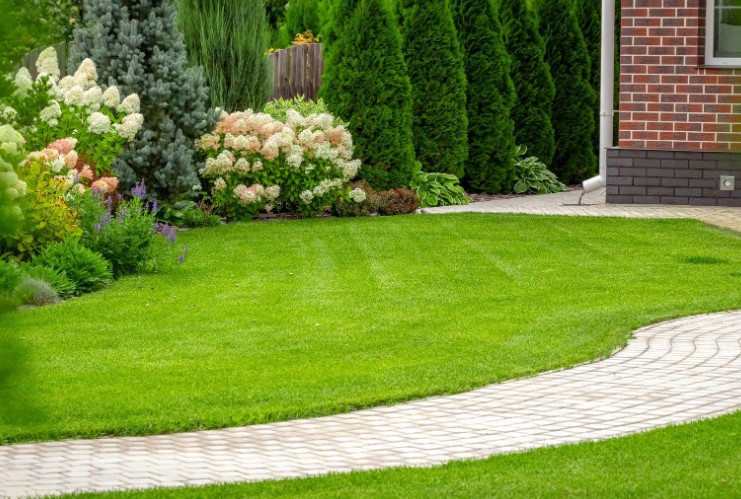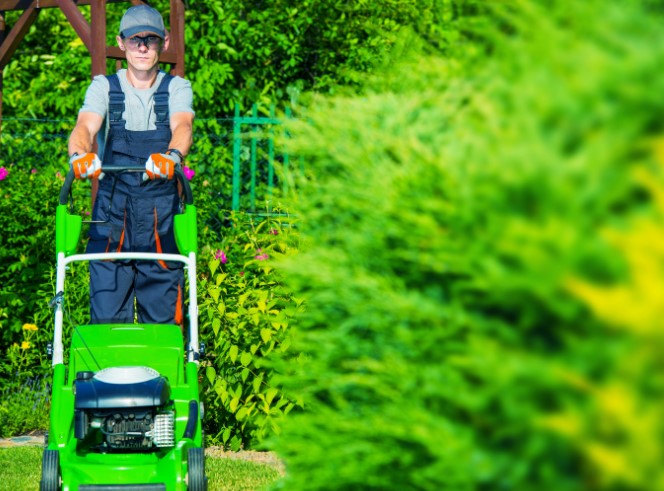- Why Is Proper Grass Cutting Important?
- How Often Should I Cut the Grass?
- What Equipment Do I Need to Cut Grass?
- How Much Does It Cost to Cut 1 Acre of Grass?
- How Short Should I Trim the Grass?
- How Often Should I Mow My Lawn?
- What Is the Best Time of Day to Cut Grass?
- How to Cut Grass Efficiently? - Step-by-Step Guide
- What are the Common Grass Cutting Mistakes to Avoid?
- What are the Pro Tips for a Perfect Lawn Finish?
- Conclusion
- FAQs About How to Cut Grass
Maintaining a perfect lawn is important. A well-kept lawn boosts curb appeal, makes outdoor spaces more enjoyable, and promotes healthy grass growth.
In this guide, I’ll share expert insights into how to cut grass effectively, from choosing the right equipment to avoiding common mistakes.
Whether you’re new to lawn care or just looking to sharpen your skills, these pro tips and tricks will help you achieve a vibrant and healthy lawn.
Why Is Proper Grass Cutting Important?
Proper grass cutting is essential for the overall health of your lawn. Regular mowing helps grass grow more evenly, promoting thicker, healthier lawns that are less prone to weeds and disease.
Cutting grass at the correct height also encourages the development of deeper roots, leading to more drought-resistant lawns.
Benefits of regular mowing include:
- Encourages thicker growth and better coverage.
- Prevents weeds from spreading.
- Reduces the likelihood of pests and lawn diseases.
- Improves the overall appearance and uniformity of your lawn.
How Often Should I Cut the Grass?
“How often should I mow my lawn?” Which might be the common question all have. However, the exact answer depends on several factors, such as the grass type, the season, and local climate conditions.
Spring and Summer:
- Mow once a week during the time of growing seasons.
- Faster-growing grass may need mowing every 5-6 days.
Autumn and Winter:
- Mow every 10 to14 days as grass growth slows.
- In winter, mow only if necessary (approximately once a month).
Remember the golden rule: Never cut more than one-third of the grass blade in a single mow. Cutting more than that can stress the grass, leading to poor health.

What Equipment Do I Need to Cut Grass?
The essential equipment you’ll need to cut grass:
- Lawn Mower: The type of mower to mow your lawn depends on your lawn size and grass type. Common mower types include:
- Rotary Mower: Suitable for most lawn types, including uneven terrain.
- Cylinder Mower: Best for fine, well-maintained lawns.
- Hover Mower: Ideal for small lawns and slopes.
- Grass Trimmer: For trimming areas the mower can’t reach, like around flower beds or pathways.
- Lawn Edger: To create neat, defined edges along borders.
Tool Maintenance Tips:
- Sharpen mower blades regularly for cleaner cuts.
- Ensure your tools are serviced annually for optimal performance.
| Equipment Type | Recommended For | Key Feature |
| Rotary Mower | General lawn use | Handles uneven ground well |
| Cylinder Mower | Well-maintained fine lawns | Provides a precise cut |
| Hover Mower | Small/sloped lawns | Easy to maneuver on inclines |
| Grass Trimmer | Trimming edges and corners | Reaches where mowers can’t |
| Lawn Edger | Neat lawn borders | Cleanly cuts along borders |
How Much Does It Cost to Cut 1 Acre of Grass?
Cutting a large area like an acre can be time-consuming and expensive, especially if you hire professional services. The cost to cut depends on several factors, including:
Labour Costs in the UK:
-
- Hiring a professional: £100 – £200 per session.
- Costs may vary based on complexity (e.g., sloped terrain, trees).
DIY Mowing Costs:
-
- Lawn mower: A reliable ride-on mower costs about £1,500 or more.
- Fuel: Mowing an acre consumes around 2 litres of fuel
- Time investment: Mowing an acre can take up to 2-3 hours, depending on the terrain.
For regular maintenance, investing in your own equipment is more cost-effective than hiring a service, especially during the growing season.

How Short Should I Trim the Grass?
Trimming your grass to the correct height is crucial for its health. The general rule is to keep grass between 2.5 to 4 cm for most lawns, though this can vary based on the type of grass:
- Cool-season grasses (like ryegrass or fescue): Trim to about 3-4 cm.
- Warm-season grasses (less common in the UK): These can be cut slightly shorter, around 2.5 cm.
Risks of cutting grass too short (scalping):
- Weakens the grass by exposing roots to excessive sunlight.
- Makes the lawn more vulnerable to disease, pests, and drought.
- Reduces its ability to recover from damage.
How Often Should I Mow My Lawn?
For the best results:
- During the growing season, mow at least once a week.
- In peak summer months, mowing every 5-6 days may be necessary.
- Observe the growth rate of your lawn to determine the ideal mowing frequency.
What Is the Best Time of Day to Cut Grass?
Timing is crucial when it comes to mowing. Here’s a breakdown of the best and worst times to mow your lawn:
- Best time: Late morning (8-10 AM) or early evening (4-6 PM).
- Grass is dry, and the temperature is moderate, reducing lawn stress.
- Worst time: Early morning or midday.
- Early morning dew makes grass wet, causing clumping and uneven cuts.
- Mowing during midday heat stresses the grass.
Avoid mowing wet grass to prevent clumping and damage to both your lawn and your mower.
How to Cut Grass Efficiently? – Step-by-Step Guide
How Should I Prepare My Lawn Before Mowing?
- Remove any debris: Clear sticks, rocks, and toys to avoid damaging your mower or causing uneven cuts.
- Check grass height: Ensure your lawn is ready for mowing and isn’t too short to avoid scalping.
What’s the Correct Mowing Technique?
To achieve a clean and even cut:
- Mow in straight, overlapping rows for uniformity.
- Alternate your mowing direction with each mow to prevent lawn ruts.
- For a striped effect, mow in straight lines using a rear roller mower.
How Should I Trim Lawn Edges?
To trim grass edges near a wall:
- Use a lawn edger: It’s essential for neat, defined borders.
- Trim after mowing: This gives your lawn a sharp, professional appearance.

What are the Common Grass Cutting Mistakes to Avoid?
- Cutting Grass Too Short (Scalping): This weakens the grass and leaves it vulnerable to stress and disease.
- Using Dull Mower Blades: Dull blades tear the grass, which can lead to a brown, unhealthy appearance.
- Mowing Wet Grass: Wet grass clumps, causing uneven cuts and potentially damaging the mower.
- Mowing in the Heat of the Day: Heat stresses the grass and slows recovery from mowing.
What are the Pro Tips for a Perfect Lawn Finish?
- Sharpen Blades Regularly: Dull blades tear rather than cut grass, which can damage your lawn.
- Change Mowing Patterns: Alternating your mowing direction anywhere prevents ruts and ensures a smooth, even finish.
- Use a Mulching Mower: This type of mower chops grass into small pieces, returning nutrients to the soil and improving lawn health.
- Watering After Mowing: Water the lawn in the morning after mowing to promote strong, healthy growth.
Conclusion
Cutting grass may seem straightforward, but doing it properly requires attention to detail. From choosing the right tools to understanding the best mowing frequency, there’s much to consider if you want to keep your lawn looking its best.
By following these pro tips and tricks on how to cut grass, you can ensure your lawn stays lush, healthy, and beautiful throughout the year.
FAQs About How to Cut Grass
1. Should I leave grass clippings on the lawn?
Yes, especially if using a mulching mower. Grass clippings might help to retain the moisture and which will return nutrients to the soil.
2. How do I know if I’m cutting grass too short?
If your lawn looks brown or patchy after mowing, you’re likely cutting too much at once.
3. Can I cut grass in the rain?
It’s best to avoid it. Wet grass clumps, making it harder to cut evenly and increasing the chance of mower damage.
4. What’s the best way to mow a sloped lawn?
Mow across the slope, not up and down, to prevent slipping and ensure an even cut.


0 Comments